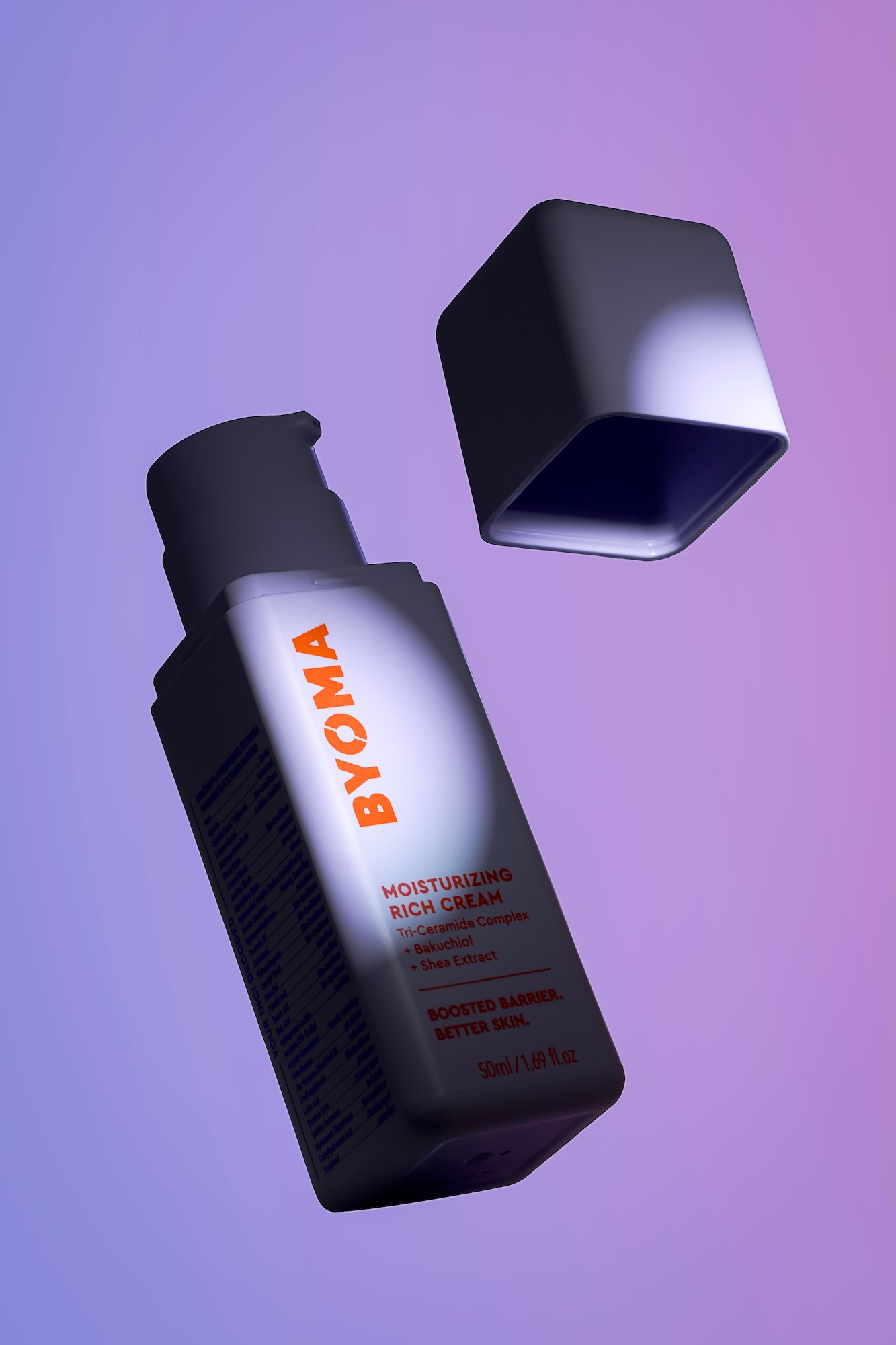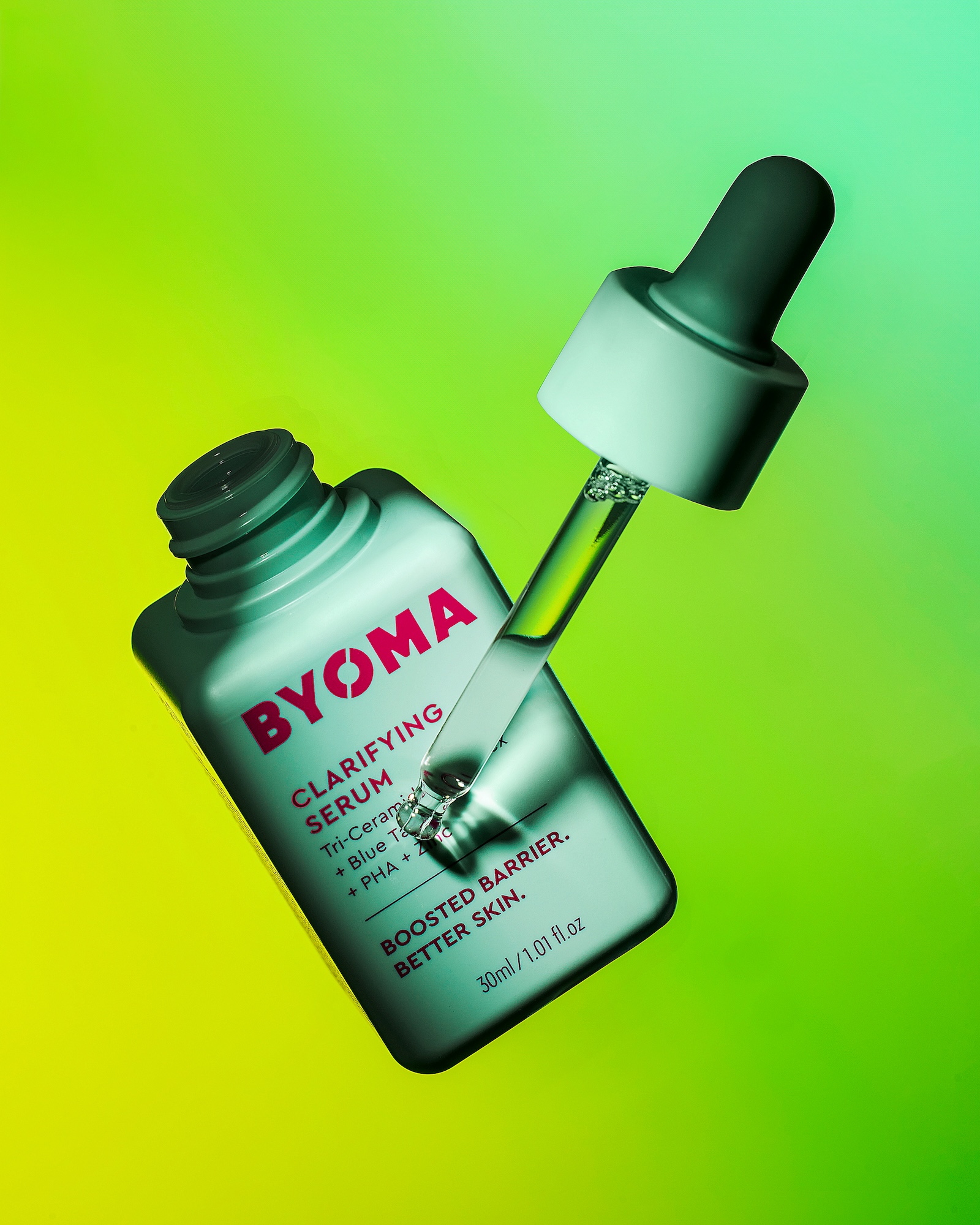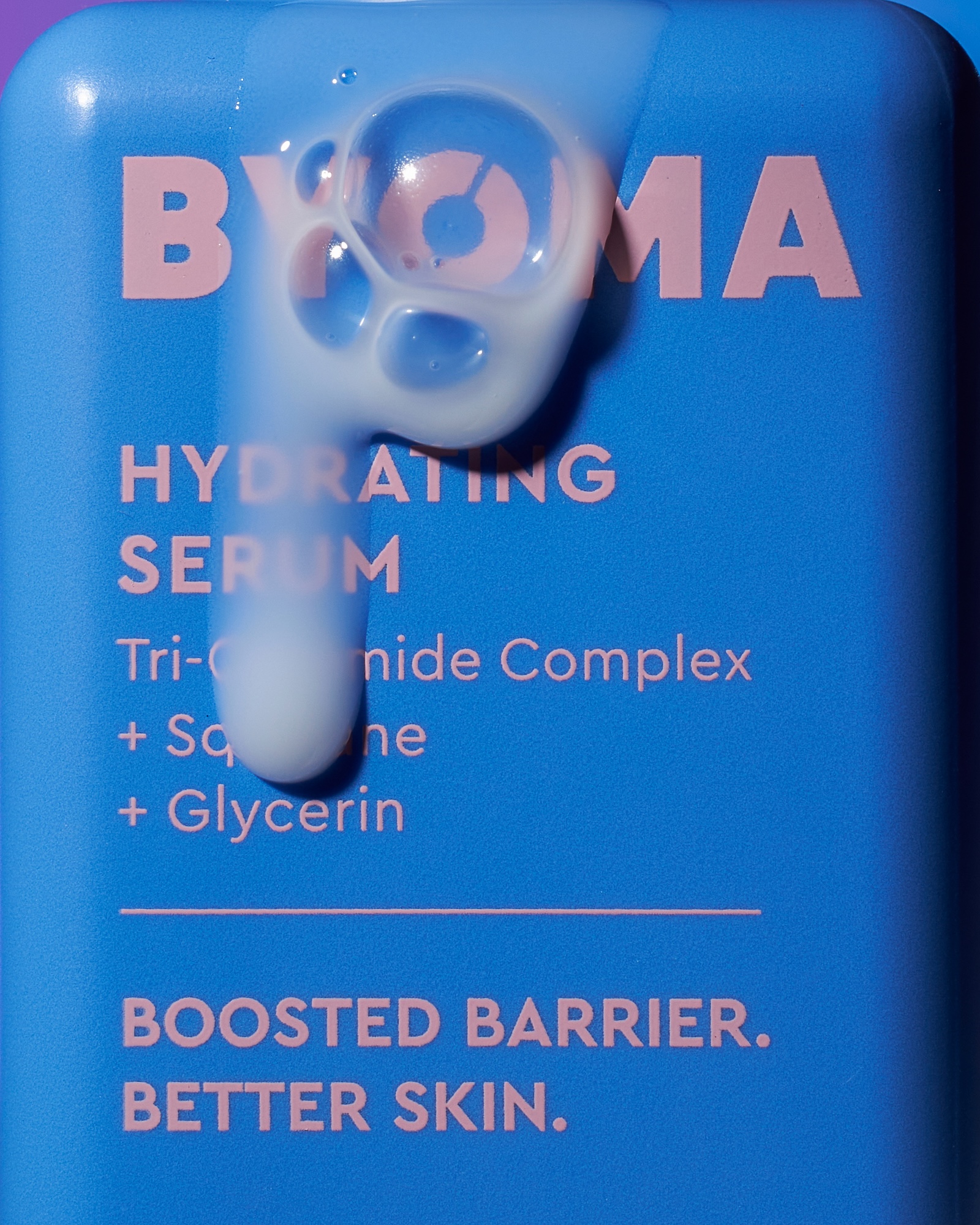The Challenge:
Making Clinical Rigor Visually Credible at Scroll Speed
When Byoma launched in 2022 with a barrier-first mission to repair the damage from years of overexfoliation and harsh actives, the brand arrived with clinical rigor most prestige lines could not match. Over fifty independent efficacy trials, dermatologist-tested formulas, and a proprietary Tri-Ceramide Complex that actually mimics skin's natural lipid structure. The challenge was not the science; it was making that science visually credible to a Gen Z audience scrolling TikTok at speed, without sacrificing the premium aesthetic that justifies shelf space beside brands three times the price.
A creative exploration inspired by Byoma's visual identity offered the perfect opportunity to solve a problem endemic to the affordable-prestige category: how do you photograph transparent serums and delicate dropper mechanics in a way that communicates clinical skincare macro product photography standards while still stopping thumbs mid-scroll? Most beauty imagery leans either sterile-lab or stock-lifestyle, rarely bridging technical proof with aspirational appeal. This portfolio project set out to close that gap.
The Brief:
Versatility Without Visual Drift Across Every Channel
If a barrier-repair brand like Byoma needed to launch a hero serum across e-commerce, social, and retail partners like Target, Ulta, and Boots, the brief would demand versatility without visual drift. The product itself, a hydrating serum built on ceramides, cholesterol, and fatty acids, is optically stunning: crystal-clear liquid, micro-bubbles suspended in glycerin, a dropper that beads perfectly when you squeeze the bulb. But clarity is also unforgiving; every smudge, every glare artifact, every blown highlight over the ingredient label becomes a credibility problem when your entire value proposition is transparency.
The strategic question became how to anchor each shot in clinical precision, delivering label-legible ecommerce skincare imagery that lets a shopper verify niacinamide percentages at a glance, while layering in the gradient background beauty product photography trend that signals modernity and cuts through the beige sameness of clean-beauty feeds. Byoma's audience does not want to choose between efficacy and aesthetics; they expect both, and the photography has to prove the brand delivers.
The Execution:
Three Interlocking Visual Systems for Clinical Credibility
The execution centered on three interlocking visual systems. First, glass serum dropper action shots captured the product mid-dispense, dropper bulb compressed, a single bead of serum falling in sharp focus while micro-bubbles clung to the interior walls. Achieving this required back-and-side lighting through diffusion to define the liquid without flare, flags positioned to carve clean highlights along the glass edges, and a shutter speed fast enough to freeze the bead but slow enough to retain the bubble texture inside the reservoir. Each frame was composed to keep the Byoma wordmark and key-ingredient callouts readable, because a beautiful dropper means nothing if the shopper cannot confirm what is inside.
Second, transparent liquid macro texture photography pushed magnification to the limit with extreme close-ups of serum clarity, refraction gradients where light bends through the fluid, and those suspended micro-spheres that make the formula feel alive and freshly compounded. Polarizing filters and controlled diffusion kept glare off the curved bottle shoulders, while a shallow depth of field isolated the hero elements and let the background gradient dissolve into soft color.
Third, the gradient backgrounds themselves, citrus yellow fading to mint and electric blue bleeding into violet, were built with gelled strobes and gradient reflection mapping, disciplined enough to spotlight the product but bold enough to assert presence in a young millennial Instagram story. Every gradient choice reinforced Byoma's ingredient story: yellow-green for freshness and botanical clarity, blue-violet for hydration and clinical calm.
A Launch-Ready Asset Library That Covers the Entire Funnel
This approach would deliver a launch-ready asset library that covers the entire funnel. Hero campaign stills with gradient drama and active droppers anchor awareness creative and could run as paid social, OOH at Ulta endcaps, or homepage carousels on byoma.com. Macro texture and bubble studies serve the education-first social strategy, offering bite-sized proof that the formula is as pure and potent as the clinical trials claim, perfect for carousel posts explaining the Tri-Ceramide Complex or Reels demonstrating product application.
Label-legible product shots with clean isolations and detail crops function as PDP workhorses, reducing pre-purchase questions, lowering return rates, and giving retail partners like Target confidence that the imagery will convert at shelf and online. Collectively, the work establishes a consistent visual language that reads premium, modern, and scientifically rigorous across every channel, solving the affordable-prestige paradox by making clinical credibility look as aspirational as any luxury serum.
The Outcome:
Translating Ingredient Transparency Into Tangible, Desirable Form
What this project demonstrates is the ability to translate ingredient transparency and barrier-health efficacy into tangible, desirable form, not through heavy retouching or artificial gloss, but through disciplined lighting, macro fidelity, and compositional choices that respect both the product's science and the audience's intelligence.
If your skincare brand is navigating the same tension, how to look credible without looking clinical and how to command attention without sacrificing clarity, let's talk about building a visual system that converts across commerce, social, and retail.
<script type="application/ld+json">
{
"@context": "https://schema.org",
"@type": "Service",
"name": "Clinical Skincare Macro Product Photography for Glass Serum Packaging",
"description": "Precision macro photography for transparent serum formulations featuring glass dropper action shots, micro-bubble texture capture, label-legible product isolations, and gradient background systems that communicate clinical efficacy and ingredient transparency for affordable-prestige skincare brands.",
"serviceType": "Commercial Product Photography",
"provider": {
"@type": "Organization",
"name": "Elina Kustlyvy Photography",
"url": "https://www.elinakustlyvy.com"
},
"areaServed": [
{"@type": "City", "name": "Vancouver", "addressRegion": "BC", "addressCountry": "CA"},
{"@type": "City", "name": "Toronto", "addressRegion": "ON", "addressCountry": "CA"},
{"@type": "City", "name": "Los Angeles", "addressRegion": "CA", "addressCountry": "US"},
{"@type": "City", "name": "Seattle", "addressRegion": "WA", "addressCountry": "US"}
],
"url": "https://www.elinakustlyvy.com/projects/byoma"
}
</script>
<script type="application/ld+json">
{
"@context": "https://schema.org",
"@type": "ImageObject",
"contentUrl": "https://cdn.prod.website-files.com/653c048c7bdcdc4c8f4346aa/688e7723f9fd90a2a8389d4f_68733c35ae5e77a5f9c0dc33_BYOMA1079.jpeg",
"url": "https://cdn.prod.website-files.com/653c048c7bdcdc4c8f4346aa/688e7723f9fd90a2a8389d4f_68733c35ae5e77a5f9c0dc33_BYOMA1079.jpeg",
"name": "Byoma Hydrating Serum Glass Dropper Action Shot with Micro-Bubble Suspension",
"caption": "Macro product photography capturing Byoma's transparent serum mid-dispense with visible micro-bubbles, controlled back-lighting to define liquid clarity, and label-legible composition demonstrating clinical ingredient transparency for ecommerce and social conversion.",
"creator": {
"@type": "Person",
"name": "Elina Kustlyvy",
"url": "https://www.elinakustlyvy.com"
},
"copyrightHolder": {
"@type": "Organization",
"name": "Elina Kustlyvy Photography"
},
"acquireLicensePage": "https://www.elinakustlyvy.com/contact"
}
</script>
<script type="application/ld+json">
{
"@context": "https://schema.org",
"@type": "Brand",
"name": "Byoma",
"description": "Barrier-first skincare brand founded in 2022 with clinically tested formulas featuring proprietary Tri-Ceramide Complex, positioned at the intersection of prestige efficacy and accessible pricing for Gen Z and millennial consumers focused on skin barrier health and ingredient transparency.",
"url": "https://byoma.com",
"sameAs": [
"https://www.instagram.com/byoma",
"https://www.tiktok.com/@byoma"
]
}
</script>
<script type="application/ld+json">
{
"@context": "https://schema.org",
"@type": "Product",
"name": "Byoma Hydrating Serum",
"description": "Barrier-repair serum built on ceramides, cholesterol, and fatty acids with Tri-Ceramide Complex, featuring crystal-clear liquid formulation with suspended micro-bubbles and precision glass dropper mechanism.",
"brand": {
"@type": "Brand",
"name": "Byoma"
},
"category": "Skincare Serum",
"review": {
"@type": "Review",
"author": {
"@type": "Person",
"name": "Elina Kustlyvy"
},
"reviewRating": {
"@type": "Rating",
"ratingValue": "5",
"bestRating": "5"
},
"reviewBody": "The crystal-clear liquid formulation with suspended micro-bubbles creates exceptional optical interest under macro photography, while the precision glass dropper produces perfectly formed beads that freeze beautifully at controlled shutter speeds. The formula's transparency and bubble texture require disciplined back-and-side lighting with careful diffusion to avoid glare artifacts while maintaining legibility of the ingredient callouts and niacinamide percentage claims on the label."
}
}
</script>
<script type="application/ld+json">
{
"@context": "https://schema.org",
"@type": "BreadcrumbList",
"itemListElement": [
{
"@type": "ListItem",
"position": 1,
"name": "Projects",
"item": "https://www.elinakustlyvy.com/projects"
},
{
"@type": "ListItem",
"position": 2,
"name": "Skincare Photography",
"item": "https://www.elinakustlyvy.com/projects/skincare-photography"
},
{
"@type": "ListItem",
"position": 3,
"name": "Byoma Clinical Macro Product Photography",
"item": "https://www.elinakustlyvy.com/projects/byoma"
}
]
}
</script>
<script type="application/ld+json">
{
"@context": "https://schema.org",
"@type": "WebPage",
"name": "Clinical Skincare Macro Product Photography That Converts: Byoma Case Study",
"description": "Portfolio case study demonstrating clinical macro product photography for Byoma's transparent serum formulations, featuring glass dropper action shots, micro-bubble texture capture, gradient background systems, and label-legible compositions that bridge clinical credibility with social-first visual appeal for affordable-prestige skincare brands.",
"url": "https://www.elinakustlyvy.com/projects/byoma",
"speakable": {
"@type": "SpeakableSpecification",
"cssSelector": [".article-intro", ".article-conclusion"]
},
"about": [
{"@type": "Thing", "name": "Clinical skincare macro product photography"},
{"@type": "Thing", "name": "Glass serum dropper action photography"},
{"@type": "Thing", "name": "Transparent liquid texture visualization"},
{"@type": "Thing", "name": "Gradient background beauty photography"},
{"@type": "Thing", "name": "Label-legible ecommerce skincare imagery"}
],
"mentions": [
{
"@type": "Brand",
"name": "Byoma",
"sameAs": "https://byoma.com"
},
{
"@type": "Thing",
"name": "Byoma Hydrating Serum"
},
{
"@type": "Thing",
"name": "Tri-Ceramide Complex"
}
]
}
</script>
<script type="application/ld+json">
{
"@context": "https://schema.org",
"@type": "HowTo",
"name": "How to Photograph Transparent Serum Formulations with Glass Dropper Action and Micro-Bubble Clarity",
"description": "Technical approach for capturing clinical-grade macro product photography of transparent skincare serums that maintains label legibility, showcases suspended micro-bubbles, and achieves glare-free clarity on curved glass packaging for ecommerce and social conversion.",
"step": [
{
"@type": "HowToStep",
"position": 1,
"name": "Capture glass dropper action shots with micro-bubble retention",
"text": "Position back-and-side lighting through diffusion panels to define the liquid without flare, deploy flags to carve clean highlights along glass edges, compress the dropper bulb to generate a falling bead, and use a shutter speed fast enough to freeze the bead mid-drop while retaining the texture of micro-bubbles clinging to the reservoir interior. Compose each frame to keep the Byoma wordmark and key-ingredient callouts readable, ensuring shoppers can verify niacinamide percentages and barrier-repair claims at a glance."
},
{
"@type": "HowToStep",
"position": 2,
"name": "Execute transparent liquid macro photography with refraction control",
"text": "Push magnification to extreme close-ups of serum clarity and refraction gradients where light bends through the fluid, revealing suspended micro-spheres that communicate fresh formulation. Deploy polarizing filters and controlled diffusion to eliminate glare off curved bottle shoulders, and employ shallow depth of field to isolate hero elements while allowing gradient backgrounds to dissolve into soft color transitions that reinforce ingredient stories—yellow-green for botanical freshness, blue-violet for hydration and clinical calm."
},
{
"@type": "HowToStep",
"position": 3,
"name": "Build gradient backgrounds with ingredient-aligned color mapping",
"text": "Construct gradient backgrounds using gelled strobes and reflection mapping techniques that spotlight the product with clinical discipline while asserting visual presence in Gen Z Instagram stories. Choose gradient transitions that reinforce Byoma's ingredient narrative: citrus yellow fading to mint for freshness and botanical clarity, electric blue bleeding into violet for hydration and clinical calm. Maintain enough control to preserve label legibility and ingredient callout visibility while creating sufficient color drama to stop thumbs mid-scroll on social feeds."
}
]
}
</script>
<script type="application/ld+json">
{
"@context": "https://schema.org",
"@type": "FAQPage",
"mainEntity": [
{
"@type": "Question",
"name": "How do you photograph transparent serum formulations without glare on glass dropper packaging?",
"acceptedAnswer": {
"@type": "Answer",
"text": "Photographing transparent serums without glare requires back-and-side lighting through diffusion panels to define liquid clarity, polarizing filters to control reflections off curved glass surfaces, and precisely positioned flags to carve clean highlights along bottle edges while preventing specular blowouts over ingredient labels. The setup must freeze falling serum beads with controlled shutter speeds while preserving micro-bubble texture inside the dropper reservoir, ensuring both visual drama and label legibility that allows shoppers to verify clinical claims and niacinamide percentages at a glance on ecommerce product pages."
}
},
{
"@type": "Question",
"name": "What macro product photography techniques improve skincare PDP conversion rates for serum brands?",
"acceptedAnswer": {
"@type": "Answer",
"text": "Macro product photography that lifts PDP conversion combines extreme close-ups of serum texture and clarity to visualize ingredient transparency, label-legible isolations with angle-managed lighting that prevents glare over typography and claims, detail crops that showcase suspended micro-bubbles and refraction gradients proving formula purity, and active dropper sequences that demonstrate product function while reducing pre-purchase questions. These techniques work together to build clinical credibility, lower return rates by confirming ingredient accuracy, and provide education-first visuals that satisfy barrier-health narratives and ingredient verification needs of Gen Z and millennial skincare consumers."
}
},
{
"@type": "Question",
"name": "How does gradient background beauty photography support ingredient transparency messaging for affordable prestige skincare brands?",
"acceptedAnswer": {
"@type": "Answer",
"text": "Gradient background photography using gelled strobes and reflection mapping creates bold color transitions—citrus yellow to mint for botanical freshness, electric blue to violet for hydration—that stop scrolling on Gen Z social feeds while maintaining disciplined spotlighting that keeps ingredient callouts and label claims readable. This approach solves the affordable-prestige paradox by layering aspirational visual appeal onto clinical precision, allowing brands like Byoma to communicate barrier-repair efficacy and Tri-Ceramide Complex benefits through color-coded ingredient stories without sacrificing the label legibility and macro texture proof that drives ecommerce conversion and builds scientific credibility with dermatologist-tested formulations."
}
}
]
}
</script>










